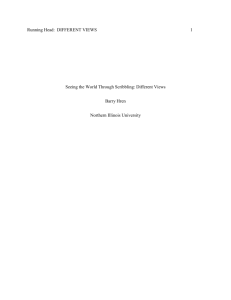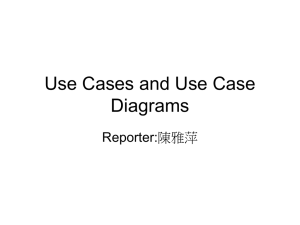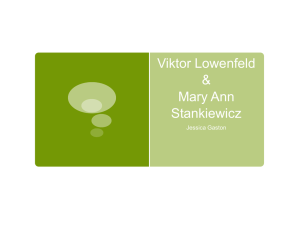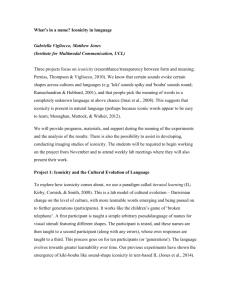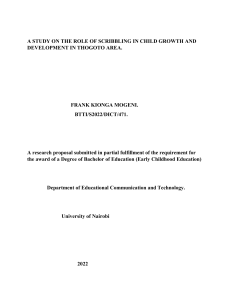Early Childhood Art- Kellogg, Lowenfeld, Darras
advertisement
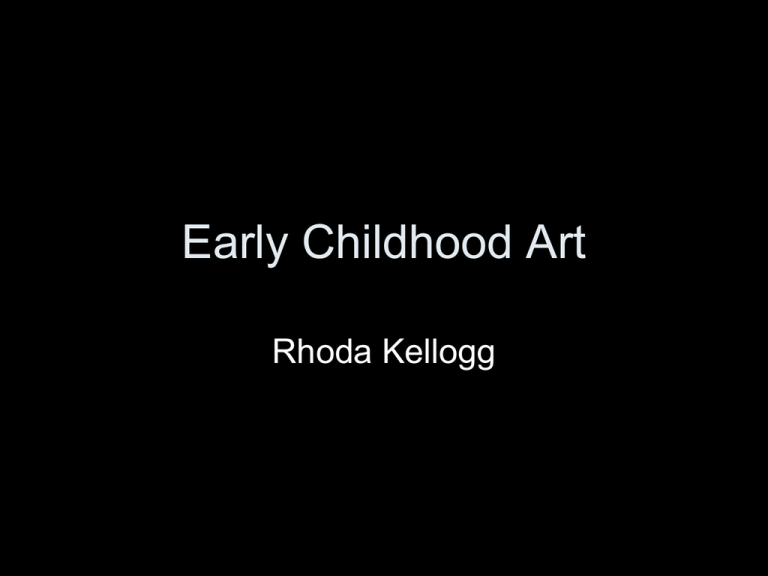
Early Childhood Art Rhoda Kellogg “I merely want you to observe that it (visual language development) is universal and is found not only in the scribbling of children but everywhere the making of signs has had a symbolizing purpose—which is from the Neolithic Age onwards.” Herbert read Evolution of Graphic Representation Kellogg Basic Scribbles – Visual interest is an essential component of scribbling, whether on not it is primary. Placement Patterns – Require a well-defined perimeter, a frame of some kind. Emergent Diagrams to Diagrams Consider this Emergent Diagram that can lead children to create Diagrams or shapes. Consider these Emergent Diagrams that lead children to create Diagrams or shapes. Simple shapes (Diagrams) are prevalent in young children's artwork. They repeat theses shape often as a way to use them in a new way. Diagrams are put together to create Combines (two shapes) Examples of Combines are readily found in young children’s drawings and paintings. More than two diagrams placed together become Aggregates; eventually leading to early Pictorials. Examples of Aggregates are readily found in young children’s drawings and paintings. When a child discovers that she can make designs, she draws confidently and with real flourish. This design has everything— circles, squares, triangles, crosses, and shapes that defy classification. Simultaneously, young children are experimenting with Mandalas, Suns and Radials which eventually become their first attempts at portraying the human form— among other representations. • Mandalas • Sun • Radial Mandalas The Sun symbol is repeated in all of these pictures— though some are faces, some are purely decoration, and some could be big fat spiders lying in wait for Little Miss Muffet. Radials can be common asterisks, plants with fronds, Fourth of July explosions, or if the center of the radial is expanded, a familiar sun. This pensive sun had its origin in a painting of the sun. One of its elongated rays forms the stem. This is a mandalatype human. The parts are arranged to fit beautifully in a circle. The lines at the top right of the painting complete the circle, not the human. There is charm in a child’s early Humans. Whatever his treatment of arms and legs and faces, the total effect is always “good design.” Note of overall balance found in these early human forms. Consider there predecessors: Mandalas, Suns, and Radials. Children’s early Pictorials are not mainly based on observations of objects and persons in the child’s environment. Aside from Humans, the early pictorialism of child art may be grouped under the following headings: Animals Buildings Vegetation Transportation Four suns, drooping smoke, and exaggerated rainbows may be necessary to give balance to children’s compositions. The first four drawings have in common the remarkable sense of spacing which is natural to children. The drawing in the upper right of the hungry cowboys home from the round-up shows perfect balance if not perfect etiquette. And what could be more balanced than the picture of the houses frolicking around in logical disorder! Objects found in early pictorials are not drawn or painted as they are found in the environment, but in sizes needed to complete patterns or achieve other aesthetic goals. The critical period in child art is between the ages of five and seven. The child who feels free to use the colors and basic shapes which please her will continue to flourish artistically when she moves into pictorial work. As a result of her research Kellogg contends: • The uniformity of child art throughout the world leads me to believe that the human mind is predisposed to remember—that is, to like—certain variations and to discard others...child art seems to be a balanced, selfregulated source of stimulus, at least until adults attempt to guide it. • Humans are not drawn from life, nor are they crude, immature, stumbling efforts in art. They represent an advanced stage of the child’s evolving mental capacity to create complex Gestalts of great interest to the human eye. • Again, drawings do not accurately reflect children’s conceptions or perceptions of objects. Consider “task demand analysis” proposed by Golomb. Viktor Lowenfeld Scribbling Stage “...It is through the process of art that art itself unfolds.” “It is not the adult’s answer but the child’s striving to her own answer that is crucial.” Lowenfeld Disordered Scribbling • Motor activity utilizing large muscles • Kinesthetic pleasure • Looks away while scribbling • Utilizes drawing surface; sometimes scribbling beyond paper • Ignores previous marks • No attempts at human representation Controlled Scribbling • Smaller marks • Repeated motions • Watches scribbles while drawing • Stays within drawing area • Draws around previous marks on the page • May concentrate on certain parts • Prefigural marks made—circles loops... Named Scribbling • Relates marks to things known • Holds tool between fingers • Identification of subject may change in the process of making • Scribbles placed purposely • Empty space may take on meaning • Lines become edges of shapes • Scribble may be identified as a person • Action may be named; such as jumping, running Preschematic Stage “A different method of drawing has begun with the creation of form; the beginning of graphic communication. Now children are consciously making forms that have some relationship to the world around them.” Lowenfeld “Although it is not clear just how the person symbol originates, the universality of the circle for the head and the two lines representing legs gives support to the notion that this is somehow biological in nature; that is, all children, either through their sight, hand control, or cognitive development, make surprisingly similar configurations for a person.” “The drawn symbol is not particularly influenced by the real world.” “At times children will regress to an earlier stage...growth is never a smooth process.” Lowenfeld • Objects seems to float around page • Paper sometimes turned or rotated while drawing • Size of objects not in proportion to one another • Objects are distorted to fit space available • People are looking at viewer, usually smiling • Distortion and omission of body parts is to be expected • Clothes, hair and other details expected by the end of this stage “Any motivation should make the art experience much more than just an activity; it should stimulate a child’s awareness of her environment and make her feel that the art activity is extremely vital and more important than anything else.” Lowenfeld Kindler and Darras Art Production is Multimedia • Biologically and culturally propelled. • Children do not lose their earlier approaches to art production, but incorporate them or return to them as needed throughout their lives. • Art production is a blend of graphic , verbal and kinesthetic expression that reveals the child’s thought processes. Biologically Propelled Selflearning Culturally Mediated Iconicity 1 • Child notices and takes interest • Resemblance – cause and effect – analogy between actions and traces • Not attentive to marks; not receptive to adult efforts • Vocal – bubbling – no meaning Iconicity 2 • Predictability (generic tendency – biological) • Invention (individuate tendency) • From cause and effect to effect itself • Emergence of predictable forms • Social interaction reinforces a particular style – “That’s nice!” Iconicity 3 • Representation Phase – images carry meaning • Substitution – action or sound can carry added meaning to the image • Making is a dynamic event – codependence on graphic, vocal and gestural Iconicity 4 • Substitutions “stand for” but are not meant to be accurate recordings of the object • Work greatly enhanced by verbal commenting and gesture; enables work to be more individual Iconicity 5 • Produce “acceptable” substitutions • “Child art” has arrived • Verbal and gestural actions assure completion and accurate understanding of their drawings
